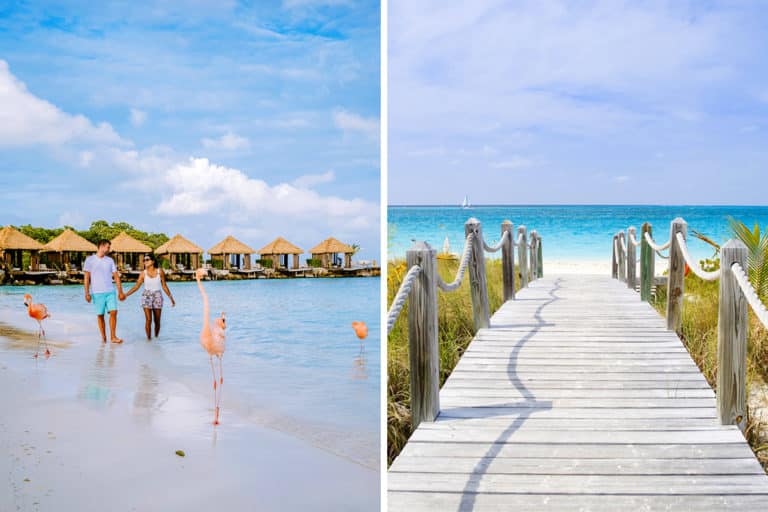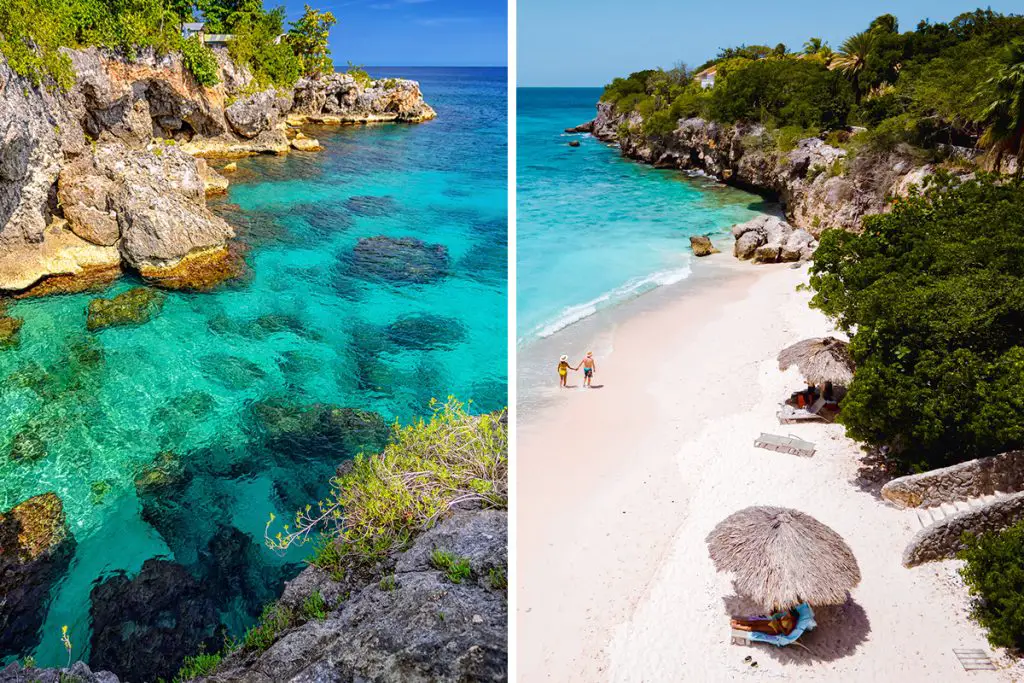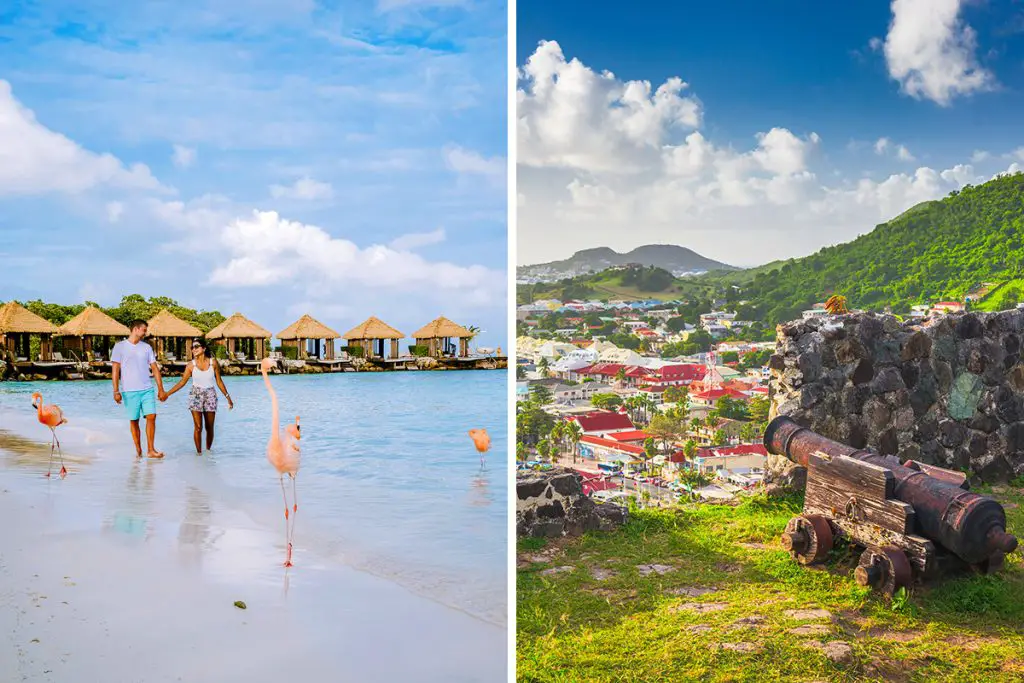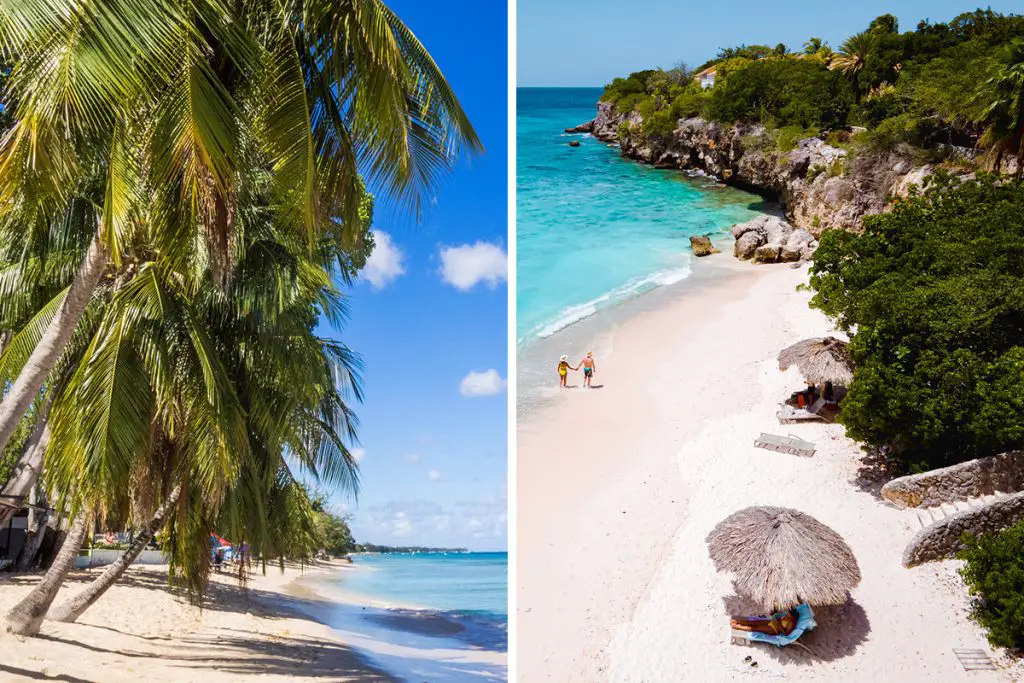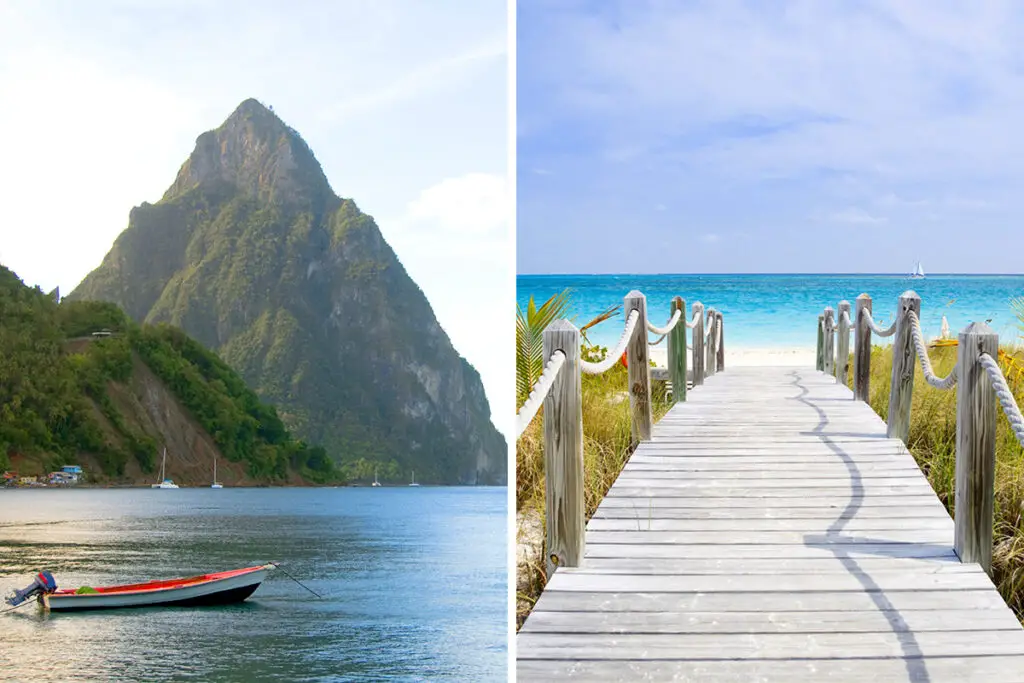While Aruba and Turks and Caicos may lie in different bodies of water but their draws will most likely have them pitted against each other. However, despite the competition, it is undeniable that both of these destinations help explain why sunny skies, blue-water white-sand beaches have always been the best places for a holiday. Aruba and Turks and Caicos are literally slices of heaven on Earth.
Aruba
Aruba is a charming treasure in the Dutch Caribbean, and its peculiarities are one of its most appealing features. Because of its many tourist attractions, such as desert-like terrains, tropical beaches, luxury resorts, snorkeling and hiking, a unique gastronomy, and multilingual population, Aruba is the most visited Dutch Caribbean Island.
Aruba is best described as a tropical paradise right out of postcards, with interior desert terrains and luxury resorts surrounding palm tree-lined beaches kissed by Caribbean waves. On the other hand, Aruba’s appeal comes at a cost: it has the highest costs in the Caribbean. Despite this, no one has yet been able to derail this small Dutch island’s aspirations of luring a significant number of interested visitors – hurricane-free weather throughout the year is merely the cherry on top.
What Makes Aruba Unique?
Hurricane-Free Days
Aruba is a great place to visit if you’re searching for a sunny vacation in the Caribbean. Aruba’s typical yearly temperatures vary from 29 to 31 degrees Celsius (84 to 88 degrees Fahrenheit), while the island’s regular easterly trade breezes keep things cool, making it ideal for a variety of outdoor activities. Aruba’s weather climate is known for its mostly hurricane-free weather, as well as its bright tropical weather all year.
Aruba, like its Dutch Caribbean neighbors Bonaire and Curacao, is located on the outskirts of the Caribbean, beyond the dreaded Hurricane Belt, and hence is unaffected by hurricanes. In terms of safety, hurricanes are no longer on your list of things to be concerned about when traveling. The hurricane season in the region runs from June to November, however, due to their location on the southern fringe of the hurricane belt, storms rarely strike the ABC Islands. Hurricane Omar, which hit the area in 2008, was the most recent hurricane to hit the area.
Beautiful Unspoilt Beaches
Despite Aruba’s beauty, the island’s beaches appear to be almost untouched due to the island’s continued prominence. Despite this, the island is surrounded on all sides by some of the world’s most tranquil and unspoiled beaches.
Eagle Beach
With a plethora of beach bars, dive schools, and tour companies, it is one of the most popular tourist destinations on the island, while still being lovely enough to give the feeling of remoteness. Go to the beaches that seem to have escaped the attention of the masses if you’re looking for genuine pure beauty.
Arashi Beach
However, because it is located just north of the major neighborhoods, you will need to rent a car to get here. Its magnificent crystal-clear blue oceans and wide views will encourage you to get behind the wheel. It is good for snorkeling, despite being a little rockier than Eagle Beach.
Hadicurari Beach
Hadicurari Beach is good for kitesurfers and windsurfers due to the consistent high winds that make it suitable for watersports. On the beach, rental shops abound, with some even offering lessons for first-timers. You can sit on the beach and people watch or watch kitesurfers if you don’t want to participate in any sports.
Boca Keto
This beach is incredibly spectacular, and it is without a doubt one of the Caribbean’s most beautiful and romantic spots. It’s one of those secluded and tranquil beaches that can only be discovered after a long hike or drive. It’s not simple to get here because it’s in the Arikok National Park, but the views are spectacular. Despite the fact that the water is too choppy to swim in, the natural beauty and remoteness more than compensate.
Andicuri Beach
Andicuri is another alternative for getting away from the crowds and is for the bravest of hearts or those seeking a sick experience. Because of the strong huge waves that are ideal for such activities, this beach is a favorite among boogie boarders and body surfers. The beach may require the usage of a 4×4 SUV or other vehicles capable of driving on dirt roads due to the limited number of vacationers.
Watersports courtesy of consistent Trade Winds
Due to its latitudes, Aruba is prone to trade winds that blow from the east, making the island appear windy, which may be bothersome to some but beneficial to others, especially watersports enthusiasts. Aruba’s proximity to the Equator attracts surface-level trade winds. On their route to the Equator, these easterly winds wash over Aruba. The island’s windier areas have daily average winds of more than 18 mph (28.9 kph), although other sports, particularly along the island’s western coastlines, have smaller gusts.
Rich and Infused Cuisine
Aruba’s cuisine is another well-known lure. Aruba’s customs are a unique mix of European, African, and South American influences. It boasts both a diversified natural scenery and a diverse gastronomic culture. Despite its small size, the island’s culinary scene is rich, with centuries of blending civilizations leading to an abundance of food.
Aruba’s food is exceptional and definitely world-class, combining flavors and characteristics from the Caribbean, Latin America, and the Netherlands. Aruba cuisine is recognized for its availability of fresh fish and shellfish, fried meals, fish soups, and light and healthy stews, all of which are influenced by the island’s lifestyle.
One of the popular traditional meals you should try if you visit Aruba is Pan Bati, a fluffy, sweet flatbread that melts in your mouth. It’s prepared in the same way as a pancake, but it’s served with a savory, non-sweet food such as soup.
Another famous dish is the Kashi Yena, which is a large cheese ball filled with spicy meat, usually chicken. Gouda, a well-known Dutch cheese, is generally served on top of this Dutch-influenced dish.
Funchi is a gouda-covered cornmeal mush that can be shaped and sized in a variety of ways depending on the maker’s imagination. Because of the banana’s innate sweetness, the plantain is frequently combined with funchi to add depth to the flavor.
The Funchi and Banana Hasa or Polenta and Fried Plantain, an Aruban rendition of the Latin-inspired dish, would not be very Latino if it didn’t have the word “platano,” which means “plantain.”
Interesting Mixed Culture
Aruba’s fascinatingly diversified culture is a result of the country’s long history as a European colony, as well as present influences from the Caribbean, Latin America, and the United States. When you get on the island, you’ll see that their culture is influenced by a blend of Spanish, Indian, and Dutch elements, as evidenced by their language, cuisine, and general disposition.
People of many races make up Aruba’s population, particularly those from neighboring countries such as Venezuela and Colombia. With a nod to their ancestors’ Native American ancestors. Oranjestad’s cuisine and colonial architecture are both influenced by the island’s Dutch colonial past.
In contrast to the rest of the Caribbean’s rowdy, raucous, fun, and inexpensive delights, Aruba is best reserved for those seeking refinement with a side of unique evenings and unusual island terrains. One of the island’s underappreciated attractions is its never-ending oddity, which includes everything from a mixed cuisine to an even more mingled people group, opposing natural qualities, and waters that rival the rest of the Caribbean. Aruba is well-deserving of its international acclaim.
Turks and Caicos
You’d know that Turks and Caicos are undoubtedly worth the flight because of its picture-perfect scenery looking straight out of travel postcards. This Caribbean Island chain is a lesser-known location with some of the world’s most breathtakingly stunning beaches, complete with sand so white it nearly sparkles and water so clean and light-blue that you can see the ocean floor for kilometers.
Spend a lot of time in and around the picture-perfect waters in the Turks and Caicos; unlike more developed Caribbean islands, shopping and city tours take a back seat to the great outdoors. Snorkeling, scuba diving, boating, and sunbathing are the major activities here. Pack a bikini and take a short flight to explore this 40-island archipelago in the Atlantic Ocean, because tropical island getaways don’t get much more beautiful than this British colony.
What Makes Turks and Caicos Unique?
Postcard Perfect Beaches
It’s a commonly known fact how heavenly Caribbean beaches are, all characteristic of white-sand beaches caressed by the turquoise blue waters of the Caribbean. Well, Turks and Caicos’ best features have to be their beaches. With vast expanses of white powder, often having a unique hint of pink, alongside calm crystal-clear waters, Turks and Caicos’ beaches are not just for views, but perfect dipping as well.
There are two things that make the beaches of Turks and Caicos extra special: the light and soft sand that is both characteristic of the surface and underwater parts of all its beaches; and the brilliantly clear blue shades of their waters.
Turks and Caicos have a particularly special light and soft sand formed from the naturally broken-down particles of shells and hard corals over the years. This resulted in the stunning white sand that often has touches of pink and peach hues, unique to many of the islands’ beaches. Plus, you’ll quickly notice that apart from the soft sand, you might notice the lack of hard rock and gravel on the beach floors, you’ll be sure to have a good time in any of Turks and Caicos’ beaches, not to mention the gorgeous aesthetic.
Thanks to a plethora of beaches in Turk and Caicos’ islands and cays, you can enjoy an abundance of beaches such as the famous Grace Bay Beach, Malcolm’s Road Beach, Northwest Point National Park, Caicos Banks, Leeward Beach, Bight Beach, and many more.
One more characteristic of Turks and Caicos’ uber-gorgeous beaches is its evident crystal-clear waters that sport light shades of blue. Upon visiting you’ll be met with Turks and Caicos’ beautiful ocean water that sport a certain shade of azure, aqua, and turquoise.
One factor for bringing such a beautiful tone to the water is the shallowness of Turks and Caicos’ depths. This is created by light refracting off white sandy ocean bottoms and fine white sand particles suspended in the water.
The Caribbean’s Finest Diving and Snorkeling
If Cancun, Cozumel, and Belize have the second largest barrier reef system in the world, Turks and Caicos have the third largest, making it a draw worth selling in itself. Thanks to the nearby reef system, it has given the islands spectacular spots to explore either by diving or snorkeling, a famous activity among the tropics.
The Turks and Caicos Islands are located on an undersea plateau that rises 10,000 feet or 3000 meters above sea level. The change from shallow to deep is fairly impressive in several locations. It’s no surprise that scuba diving and snorkeling enthusiasts picked the Turks and Caicos as having the greatest diving in the Caribbean, thanks to the quantity of beautiful coral and aquatic life. You can check out the Scuba Diving Magazine for the testimonial.
The Friendly English-Speaking Locals
Apart from its indisputable natural beauty, another highlight in your Turks and Caicos experience is the people themselves. Also called “Belongers”, the locals are known to be warm and friendly, their genuine welcome and fun-loving nature make every visitor feel included like you’re a part of the community.
If that’s not a draw alone, Turks and Caicos are a British Overseas Territory which means they’re mainly anglophones, being able to speak fluently, you can be sure to have an easy time. Apart from its fun-loving nature, the people are also peace-loving, boasting a culture that hasn’t had any revolution or coups. As a bonus, they easily accept US dollars and have US power outlets and voltages.
Watersport Hotspot
Thanks to its exquisite beaches with excellent conditions for fun and thrills, different sorts of watersports can be done in Turks and Caicos. Long Bay Beach, Providenciales, has calm waters that are ideal for kitesurfing. With a vast sandy beach flowing along the flat blue waves, it is a perfect position. Whether you’re a novice or a seasoned veteran, you won’t want to miss out on this once-in-a-lifetime opportunity.
Apart from kitesurfing, you can also try your hand at windsurfing, paddleboarding, kayaking, and many more, or if you want to conquer more of the water you can rent out a jet ski or take a catamaran cruise. If instead you just want to laze away your time beside the water, you can have the beauty of Grace Bay Beach to relax.
Turks and Caicos, though not equally famous as Aruba, or Cancun for that matter, not so developed, has its fun share of things to be awe-inspired of. Just the beauty of its beaches alone could send the best of the Caribbean a run for their money. Think pure beach culture, with a heavy serving of natural beauty, you might not want to get out of the water. The magic of Turks and Caicos continues to charm everyone who lays their eyes on its picturesque beauty, even just on postcards and travel promos.
Should I Go to Aruba or Turks and Caicos?
When it comes to the unbelievable, jaw-dropping natural beauty, the beaches of Aruba and Turks and Caicos will always take center stage. Often considered as two of the Caribbean’s most beautiful, it can be pretty challenging to decide which should you visit. But the thing is, they’re often pedestaled beauty does have their own sets of differences that can be subject to competition, but at the end of the day, whatever floats your boat, is the best go-to factor.
Aruba in all its splendor is Americanized and caters largely to mass tourism, evident in its cosmopolitan scene juxtaposed against its natural beauty. This little Dutch island is best reserved for those looking to have a great mix of entertainment and classic beach culture. You can have all of Aruba’s 40+ beaches by day, and party, shopping, or even casinos all night.
Turks and Caicos on the other hand spell different, almost too different than the rest of the Caribbean’s greatest. These islands in the northern edges of the Caribbean, arguably is in the Atlantic Ocean, along with The Bahamas, is a gifted group of islands that offer nothing but the classic beach culture that is best for the much-needed R&R, minus the cosmopolitan scene. The raw beauty of Turks and Caicos in themselves are enough to be revered as one of the tropic’s most-visited destinations.
FAQ
Is Aruba or Turks and Caicos More Expensive?
One primary thing you should know about Aruba is that it is notoriously expensive. In fact, apart from Anguilla, and St. Barts, Aruba is one of the most expensive places to visit in the Caribbean. However, Turks and Caicos loom beyond the Caribbean, in the Atlantic, is yet another entry as one of the most expensive destinations, probably booting out Aruba itself.
To have an overview of their costs, we need to compare the costs of certain purchases and services. You can do this by looking up prices online to get an estimate of how much you might need to bring. First off, an inexpensive meal in Aruba would cost around 10 to 20 USD, while in Turks and Caicos it can set you back around 15 to 55 USD, with such an obvious disparity you can already conclude that Turks and Caicos are pretty pricier.
If you take a look at other smaller purchases, however, they may be cost the same, like a local draught beer in both destinations would cost 4 to 7 USD, and a bottle of water costs around 2 to 4 USD. Transportation in Turks and Caicos can be pricey as well, with fares ranging from 2 to 5 USD, while Aruba costs around 2 to 3 USD. However, according to part visitors to Turks and Caicos, transportation on the island is subpar, and you may not get your money’s worth.
By comparing possible prices, and service quality, just by doing due diligence online will save you energy in making decisions, and just might help expand your budget. Whichever you decide, it is clear that Turks and Caicos, to a degree, boots out Aruba’s expensive delights.
Is Aruba or Turks and Caicos Bigger?
Aruba is an island nestled south of the Caribbean, with an approximate total landmass of 180 sq. km. The Dutch Caribbean Island is famously known for being small yet packing large punches when it comes to tourism, thanks to its sheer beauty and quirkiness.
Turks and Caicos on the other hand, a collection of islands and cays that makes up an estimated total landmass of 948 sq. km, making it larger than Aruba. However, getting around Turks and Caicos is more difficult due to transportation systems, and the many various islands across the area.
Where Is Aruba Compared to Turks and Caicos?
Aruba sits south of the Caribbean, right at the northern coast of Venezuela, straddling an entire sea south of Turks and Caicos. The latter is located in the southern Atlantic Ocean, north of Hispaniola (the island of Haiti and the Dominican Republic), and sitting right next to The Bahamas.
Aruba is approximately 1,034 kilometers or 642 miles from Turks and Caicos, directly. The best and only way to get in between them is by flying. You can get in between them with air carriers such as United Caribbean Airlines, Divi Divi Air, InterCaribbean, and many others.
Is Aruba Near Turks and Caicos?
You have a literal sea to cross to get in between Aruba and Turks and Caicos. With a whopping direct distance of 1,034 kilometers or 642 miles. Aruba is far from Turks and Caicos.
How Do I Get From Turks and Caicos to Aruba?
With their great distance, the only way to get from Turks and Caicos to Aruba is by flying. You can get in between them with air carriers such as United Caribbean Airlines, Divi Divi Air, InterCaribbean, and many others.
How Long Is the Flight From Aruba to Turks and Caicos?
The great distance might result in transfers or layovers in between. The fastest flight usually takes around 10 hours, however, with many other factors you can expect to fly around 16 to 20 hours.

